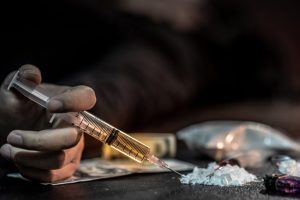On This Page:
What is Salvia?
Salvia, scientifically known as Salvia divinorum, is a perennial herb in the mint family, traditionally known for its psychoactive properties when consumed.
Native to the cloud forests of the Sierra Mazateca in Oaxaca, Mexico (South America), Salvia grows in isolated, shady, and moist areas. Over the years, its cultivation has expanded to various regions globally, mainly for ornamental and ethnobotanical purposes.
Scientific research on Salvia is ongoing, and its effects can vary greatly among users. However, most studies suggest that Salvia does not have the classic hallmarks of drugs that induce physical dependence.
Unlike substances such as opioids or alcohol, Salvia does not seem to lead to compulsive use, nor does it produce the typical withdrawal symptoms associated with addiction. Nonetheless, its psychoactive properties are potent, leading to its regulation in many countries.
Traditionally, Mazatec shamans (indigenous spiritual leaders in Oaxaca, Mexico) used Salvia for spiritual rituals, often chewing its fresh leaves or brewing them into a concoction for consumption.
More recently, people have been known to chew its fresh, smoke-dried leaves or consume Salvia as an extract. The onset, duration, and intensity of its effects can vary depending on the method of consumption.
Given the potency and unpredictability of its effects, caution is always advised, and it’s essential to be informed of local laws concerning its possession and use.
What Are the Street Names of Salvia?
The street names of salvia are listed below:
- Sally-D
- Maria Pastora
- Magic Mint
- Diviner’s Sage
- Shepherdess’s Herb
- Diviner’s Mint
- The Female
- Sage Of The Seers
Is Salvia a Plant?
Yes, Salvia is a plant. It’s one of approximately 900 species in the Salvia genus. Specifically, Salvia divinorum stands out due to its unique psychoactive & hallucinogenic effects, which differentiate it from other salvia species often used ornamentally or medicinally.
The plant has green leaves and can produce white or purple flowers under optimal conditions. Traditional use and its effects have made it a subject of interest both culturally and scientifically.
What is Salvia Addiction?
Salvia addiction refers to the potential repeated use and psychological dependency on the psychoactive plant, Salvia divinorum.
While scientific research suggests that Salvia doesn’t lead to physical dependence in the same manner as substances like opioids or alcohol, its potent psychoactive effects can result in some individuals seeking repeated experiences.
The understanding of Salvia’s addictive potential is still evolving, and its unique impact on the brain necessitates further investigation.
Is Salvia Addictive?
Based on current research, the addictive potential of Salvia remains uncertain, though it possesses potent hallucinogenic properties. Nonetheless, the Drug Enforcement Agency (DEA) labels Salvia as a “drug of concern” because of its possible misuse.
Can You Get Addicted to Salvia?
Salvia’s addictive nature remains a subject of ongoing research. Some people might feel a strong urge to use it because of how it affects their thoughts. When taken, Salvia’s main part, called salvinorin A, changes how our brain sees things.
Is Salvia Abuse Related to Its Psychoactive Properties?
Yes, salvia abuse is related to its psychoactive properties. Salvia’s psychoactive effects are caused by a chemical called salvinorin A. When consumed, salvinorin A attaches to specific opioid receptors in the brain, leading to alterations in perception, mood swings, and unpredictable behaviors.
The hallucination-inducing effects of salvia, such as loss of touch with reality, vivid colors and patterns, and depersonalization, are directly related to its psychoactive properties.
What Are the Side Effects of Salvia Abuse?
The most notable side effects when misusing Salvia include visual distortions, physical disorientation, and feelings of depersonalization. Reducing or stopping the consumption of Salvia can often alleviate these symptoms. In extreme or prolonged use cases, individuals might experience more severe psychological impacts, including intense paranoia, anxiety, or memory issues. It’s crucial to approach Salvia cautiously, recognizing its potent effects and understanding that the full range of long-term consequences is still being researched.
What Are the Short-Term Effects of Salvia Abuse?
Short-term effects of Salvia Abuse include:
- Visual distortions
- Physical disorientation
- Depersonalization (feeling detached from oneself)
- Dizziness or nausea
- Altered perception of time
- Uncontrollable laughter
- Rapid mood swings
- Speech difficulties
- Paranoia or anxiety
- Memory lapses or problems recalling the experience
What Are the Long-term Effects of Salvia Abuse?
While there aren’t many research studies on the long-term effects of Salvia abuse, it is known that prolonged Salvia use can affect learning and memory. Reports also indicate anxiety and challenges in returning to normal after intense experiences.
In rare cases, users might exhibit psychotic symptoms. Additionally, mixing Salvia with substances like alcohol or stimulants heightens the risk of complications, including overdose.
Can You Overdose on Salvia?
Overdose is possible if Salvia is mixed with other substances like alcohol or stimulants. Combining these substances can amplify their effects on the central nervous system, leading to unexpected and intensified reactions. This combined impact might result in respiratory depression, cardiovascular complications, or other life-threatening symptoms.
Thus, while Salvia alone might not commonly cause overdose, its interaction with other substances raises the risk.
Is frequent use of salvia linked to potential health risks?
Yes, frequent use of Salvia is linked to potential health risks.
While the full spectrum of long-term effects is still being researched, some reported risks associated with chronic Salvia use include:
- Difficulties with thought processes, memory, and concentration
- Anxiety
- Ongoing feelings of detachment from oneself
- Aggravation of underlying mental health conditions
- Experiencing hallucinogenic effects without recent intake.
What Are the Signs and Symptoms of Salvia Dependence?
Salvia is particularly difficult to detect since many methods of consuming salvia leave very few physical traces. No drug paraphernalia will be left around when someone eats salvia leaves or brews them into tea. Smoking is often easier to detect since it requires a small pipe, and the smell of smoke is quite noticeable.
Another reason salvia abuse is often difficult to detect is that the effects are so short-lived. Most people remain high on salvia for only a few minutes, which can make it difficult to catch someone in the act of getting high on salvia.
However, if someone is behaving out of the ordinary, there is a good chance they are intoxicated. Common signs of symptoms of recent salvia abuse include:
- Uncoordinated movements
- Physical imbalance
- Slurred speech
- Chills
- Seeming disconnected from reality
- Bouts of uncontrollable laughter
- Being more emotional than normal
Given the short-lived effects, the likelihood of discovering someone while they are high on salvia is low. However, if a person is abusing drugs and alcohol, their behavior is likely to be markedly different even while they are not intoxicated. Common behavioral and physical signs of salvia addiction include:
- Sudden weight loss or weight gain
- Sleep problems, including insomnia or oversleeping
- Lack of attention to grooming
- Unusual body odors
- Irritability, anxiety, or depression
- Aggression or violent behavior
- Increased social isolation
- A change in social groups (spending time around known drug users)
- Worsened work or academic performance
- A decreased interest in activities and hobbies that formerly gave them pleasure
- Increased talk or joking about drugs or alcohol
- An unexplained need for money
- Legal problems
How Do People Abuse Salvia?
Salvia is typically consumed either as dried leaves or as a liquid extract. When smoked, akin to marijuana, users often utilize pipes to inhale the dried leaves. This method results in a swift onset of effects, peaking within 2 minutes and generally subsiding around 30 minutes post-consumption. Pronounced perceptual alterations characterize the high.
If the Salvia leaves are chewed, they release the active compound salvinorin A. This chemical is absorbed via the mouth’s inner lining, inducing vivid hallucinations and cognitive shifts that can persist for 1 to 2 hours. Liquid Salvia extracts can be merged with beverages, or the herb can be inhaled, offering another avenue for its psychoactive effects.
How Long Does Salvia Last in a Person’s System?
Clinical tests have shown that salvia has a half-life of only about 60 minutes. This means that the drug’s subjective effects wear off in only a few minutes, and the body eliminates half of the drug in only an hour.
The half-life of salvia is very rapid compared to other common drugs of abuse, such as prescription opioids or even marijuana. This can make salvia abuse difficult to detect using standard drug tests. Only a few costly specialized drug test kits can detect salvia abuse. However, even these tests can often only detect salvia abuse shortly after consumption.
Is Salvia Legal?
Salvia is easy for people to obtain. In fact, in many states of the United States, it is perfectly legal to buy salvia in a store. There is no federal ban on Salvia; however, several states have instituted their regulations concerning the plant:
Here’s a general breakdown of the legal categories across states in the United States:
Banned States: In these states, Salvia is illegal to manufacture, distribute, possess, or use. States that have prohibited Salvia include but may not be limited to:
- Alabama
- Arkansas
- Colorado
- Delaware
- Florida
- Georgia
- Hawaii
- Illinois
- Indiana
- Iowa
- Kansas
- Kentucky
- Louisiana
- Maryland
- Michigan
- Minnesota
- Mississippi
- Missouri
- Nebraska
- North Carolina
- North Dakota
- Ohio
- Oklahoma
- Pennsylvania
- South Carolina
- South Dakota
- Tennessee
- Texas
- Vermont
- Virginia
- Wisconsin
- Wyoming
Restricted Sale: Some states allow possession but have restricted its sale, especially to minors. Examples include:
- California (illegal to sell to minors)
- Maine (illegal to sell to minors)
No Regulations: States where Salvia remains legal and unregulated as of my last update, include:
- Alaska
- Connecticut
- Idaho
- Massachusetts
- Montana
- New Hampshire
- New Mexico
- New York
- Rhode Island
- Washington
- West Virginia
Note: Even in states where Salvia is legal, local (city or county) regulations might still apply. Besides, laws and regulations can change over time, so it’s always essential to check the most current legal status directly from state or local government sources or consult a legal professional before acquiring or using Salvia.
Is it legal to consume salvia in all countries?
No, Salvia divinorum’s legal status varies widely from one country to another. Here’s a general overview of its legal status in various countries:
Illegal or Controlled:
- Australia: Banned in most states and territories.
- Canada: Legal for possession and cultivation, but selling it for human consumption is illegal.
- Denmark: Classified as a controlled substance.
- Finland: Salvia is considered a medicinal product, and sale without a license is prohibited.
- Germany: Salvinorin A is listed as an Appendix I designated drug, making unauthorized production, sale, or possession illegal.
- Italy: Salvia is illegal to produce, sell, or possess.
- Japan: Import and sale are banned.
- South Korea: Salvia is classified as a controlled substance.
- Norway: Classified as a narcotic substance.
- Russia: Banned.
- Sweden: Listed as a narcotic.
- United Kingdom: Salvia divinorum and salvinorin A are illegal to produce, supply, or possess with intent to supply under the Psychoactive Substances Act 2016.
Legal or Unregulated:
- Mexico: Interestingly, it remains legal considering Salvia’s indigenous use in Oaxaca.
- The Netherlands: Salvia is legal and is often available in “smart shops.”
- Spain: Legal for sale and possession.
- United States: As mentioned earlier, the legality varies by state.
Ambiguous or Unclear:
Many countries, including some Asian countries such as China, India, Indonesia, Malaysia, Thailand, and Vietnam, have not explicitly legislated on Salvia, leading to a legal gray area.
Are There Rehabilitation Centers That Address Salvia Abuse?
Yes, there are rehabilitation and sober living homes that address salvia abuse. Salvia is recognized as a potent hallucinogenic drug.
While its effects may be brief, individuals who misuse salvia often have a history of using other drugs, such as LSD, MDMA, heroin, phencyclidine, and cocaine. The repercussions of abusing these substances can lead to significant legal, financial, interpersonal, and health challenges. Salvia abuse might not be as widely known as other drugs, but its consequences can be equally severe.
Those struggling with salvia or polysubstance abuse should seek help, as many rehabilitation centers offer supportive environments and programs tailored to address such issues.

























